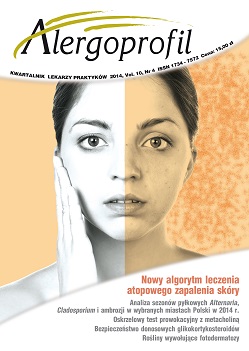Rośliny wywołujące fotodermatozy
##plugins.themes.bootstrap3.article.main##
Abstrakt
W pracy opisano czynniki, które mogą wywoływać fotodermatozy, w tym fotoalergię i reakcje fototoksyczne. Przedstawiono też gatunki roślin zawierające furanokumaryny, które najczęściej powodują fotodermatozy w warunkach Europy. Rośliny te należą do rodzin: Apiaceae, Rutaceae i Moraceae. Większość wymienionych gatunków to rośliny uprawne. Wyróżniono rodzaje tkanek, w których powstają substancje fototoksyczne. Podano charakterystykę trzech gatunków roślin często wywołujących fotodermatozy w Europie Środkowej. Fragmenty roślin oraz tkanki wytwarzające i emitujące substancje fototoksyczne przedstawiono na fotografiach.
Pobrania
##plugins.themes.bootstrap3.article.details##
Copyright: © Medical Education sp. z o.o. This is an Open Access article distributed under the terms of the Attribution-NonCommercial 4.0 International (CC BY-NC 4.0). License (https://creativecommons.org/licenses/by-nc/4.0/), allowing third parties to copy and redistribute the material in any medium or format and to remix, transform, and build upon the material, provided the original work is properly cited and states its license.
Address reprint requests to: Medical Education, Marcin Kuźma (marcin.kuzma@mededu.pl)
Bibliografia
2. Bowers A.G.: Phytodermatitis. Am. J. Contact Dematitis 1999, (10), 2: 89-93.
3. Sadowska A.: Rakotwórcze i trujące substancje roślinne. Wydawnictwo SGGW, Warszawa 2004.
4. Alvarez M., Jacobs S., Jiang B.S. et al.: Photocontact allergy to dallyl disulfide. Am. J. Contact Dermatol. 2003, 14: 161-165.
5. Śpiewak R.: Pathomechanism of photoallergic dermatitis. W: Photoallergy and photopatch testing. Śpiewak R. (red.). Institute of Dermatology. Kraków 2009: 2-26.
6. Śpiewak R.: Food-provoked eczema: A hypothesis on the possible role of systemic contact allergy to haptens present in both cosmetics. Estetol. Med. Kosmetol. 2011, 1(1): 35-40.
7. Śpiewak R.: Pesticides and skin diseases in man. W: Pesticides: Evol. Environm. Pollution. Rathor H., Nolet L.M. (red.). CRS Press, Boca Raton 2012: 525-542.
8. Szewczyk K., Śpiewak R.: ‘Sun alergy’ or photodermatoses: how frequent are they in Poland? Allergy 2009, 64(supl. 90): 280.
9. Śpiewak R.: The substantial differences between photoallergic and phototoxic reactions. Ann. Agric. Environm. Med. 2012, 19(4): 888-889.
10. Epstein J.H.: Phototoxicity and photoallergy. Semin. Cutan Med. Surg. 1999, 18(4): 274-284.
11. Kreimer-Erlacher H., Seidl H., Bäck B. et al.: High mutation frequency at Ha-ras exons 1–4 in squamous cell carcinomas from PUVA-treated psoriasis patients. Photochem. Photobiol. 2001, 74(2): 323-330.
12. Podbielkowski Z., Sudnik-Wójcikowska B.: Słownik roślin użytkowych. Państwowe Wydawnictwo Rolnicze i Leśne, Warszawa 2006.
13. Faed M.J.W., Peterson S.: Effect of 8-methoxypsoralen in the dark on sister-chromatid exchange frequency in human lymphocytes. Mutation Res. 1980, 78: 389-391.
14. White I.R.: Phototoxic and photoallergic reactions. W: Texbook of contact dermatitis Springer Verlag, Rycroft R.J. (red.). Berlin Heidelberg 1992.
15. Gonçalo M.: Phototoxic Dermatitis. W: Kanerva’s Occupational Dermatology. Rustemeyer T., Elsner P., John S.M. et al. (red.). Springer-Verlag, Berlin Heidelberg 2012.
16. Langley D.M., Criddle L.M.: A 43-year-old woman with painful, vesicular lesions from giant hogweed photodermatitis. J. Emerg. Nurs. 2006, 32(3): 246-248.
17. Carlsen K., Weismann K.: Phytophotodermatitis in 19 children admitted to hospital and their differential diagnoses: Child abuse and herpes simplex virus infection. J. Am. Acad. Dermatol. 2007, 57(5 supl.): S88-91.
18. Zobel A.M., Brown S.A.: Dermatitis-inducing furanocoumarins on leaf surfaces of eight species of rutaceous and umbelliferous plants. J. Chem. Ecol. 1990, 16(3): 693-700.
19. Kohlmünzer S.: Farmakognozja. Wydawnictwo Lekarskie PZWL, Warszawa 2013.
20. Knuchel M., Luderschmidt C. Bullous phototoxic dermatitis caused by Dictamnus albus. The Bible’s “burning bush”. Detesh. Med. Wochenschr. 1986, 111(38): 1445-1447.
21. Schempp C.M., Sonntag M., Schopf E. et al.: Dermatitis bullosa striata pratensis caused by Dictamnus albus L. (burning bush). Hautarzt 1996, 47(9): 708-710.
22. Tokarska-Guzik B., Dajdok Z., Zając M. et al.: Rośliny obcego pochodzenia w Polsce ze szczególnym uwzględnieniem gatunków inwazyjnych. Generalna Dyrekcja Ochrony Środowiska, Warszawa 2012.

